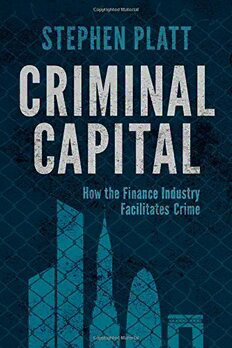
Criminal Capital: How the Finance Industry Facilitates Crime PDF
Preview Criminal Capital: How the Finance Industry Facilitates Crime
CRIMINAL CAPITAL C R I M I N A L C A P I T A L HOW THE FINANCE INDUSTRY FACILITATES CRIME STEPHEN PLATT © Stephen Platt 2015 Foreword © Robert Mazur 2015 All rights reserved. No reproduction, copy or transmission of this publication may be made without written permission. No portion of this publication may be reproduced, copied or transmitted save with written permission or in accordance with the provisions of the Copyright, Designs and Patents Act 1988, or under the terms of any licence permitting limited copying issued by the Copyright Licensing Agency, Saff ron House, 6–10 Kirby Street, London EC1N 8TS. Any person who does any unauthorized act in relation to this publication may be liable to criminal prosecution and civil claims for damages. Th e author has asserted his right to be identifi ed as the author of this work in accordance with the Copyright, Designs and Patents Act 1988. First published 2015 by PALGRAVE MACMILLAN Palgrave Macmillan in the UK is an imprint of Macmillan Publishers Limited, registered in England, company number 785998, of Houndmills, Basingstoke, Hampshire RG21 6XS. Palgrave Macmillan in the US is a division of St Martin’s Press LLC, 175 Fift h Avenue, New York, NY 10010. Palgrave Macmillan is the global academic imprint of the above companies and has companies and representatives throughout the world. Palgrave® and Macmillan® are registered trademarks in the United States, the United Kingdom, Europe and other countries ISBN: 978–1–137–33729–0 Th is book is printed on paper suitable for recycling and made from fully managed and sustained forest sources. Logging, pulping and manufacturing processes are expected to conform to the environmental regulations of the country of origin. A catalogue record for this book is available from the British Library. A catalog record for this book is available from the Library of Congress. For Joshua & William CONTENTS Foreword viii Preface x Acknowledgements xi 1 Harmful Practices 1 2 Money Laundering Models 21 3 Onshore/Off shore Dichotomy 52 4 Drug Traffi cking 65 5 Bribery and Corruption 84 6 Piracy 104 7 Traffi cking of Human Beings and Smuggling of Migrants 121 8 Terrorism Financing 138 9 Sanctions-Busting 153 10 Tax Evasion/Avoidance 170 11 Causes and Solutions 188 Notes 207 Index 221 FOREWORD By the winter of 1988 I had just finished several years of deep undercover work, living as a money launderer for Pablo Escobar and his closest associates. My covert life had taken me to many interesting places including the boardroom of what some have described as the dirtiest bank of all time – the Bank of Credit and Commerce International. BCCI was the seventh largest privately held bank in the world, a global powerhouse that catered to drug lords, arms dealers, ter- rorists and big-time tax evaders. As gatekeepers for the fortunes of the under- world, BCCI bankers taught me every money laundering trick they knew. The investigation resulted in nearly 100 drug traffickers, money launderers and bankers being arrested. The scandal made the headlines for years as everyone, including governments, reeled from the shock that one of the world’s largest banks was inextricably intertwined with some of the world’s most toxic indi- viduals. Shortly afterwards, death threats forced me and my family to go into hiding. While preparing to testify in the resulting criminal trials in the United States and Europe, I noticed an unfamiliar face at the US Customs office in Tampa. A young student from London had been given a once-in-a-life time opportunity to study our work in pursuit of his university thesis. My stints in the office were short and guarded, so I observed him only from a distance. That student was Stephen Platt. Twenty-three years later, I met him and realised that he was the student I had seen in Tampa all those years before. His decision to pursue a career in law and financial crime prevention in particular was, it tran- spires, strongly influenced by the BCCI case. I am grateful for that because his journey since has been remarkable. It has imbued him with a deep expertise of the criminal vulnerabilities of financial services in both on – and offshore financial centres. He is now justifiably regarded as one of the world’s leading practitioners in the field, trusted by governments and regulators alike to under- take highly sensitive investigations which are often systemically important to the jurisdictions concerned. In Criminal Capital, Stephen has given us an invaluable gift. He catapults the reader’s knowledge about the methods used by criminals to commit crimes and launder their proceeds with the help of the finance industry. He examines FOREWORD ix a range of different predicate crime types and explains how they generate vast fortunes that are retained by criminals who exercise enormous leverage over banks and sometimes the jurisdictions in which they operate. Guiding the reader through some of the biggest bank laundering scandals of the past decade he considers why money laundering is causally linked to a range of other harm- ful behaviours in finance, including excessive risk taking, mis-selling and rate rigging. This is a well-researched and powerful book. It should be a required reading for compliance professionals in finance as well as policymakers charged with implementing meaningful reform of the banking industry. Robert Mazur Former US Federal Agent Author of The Infiltrator
